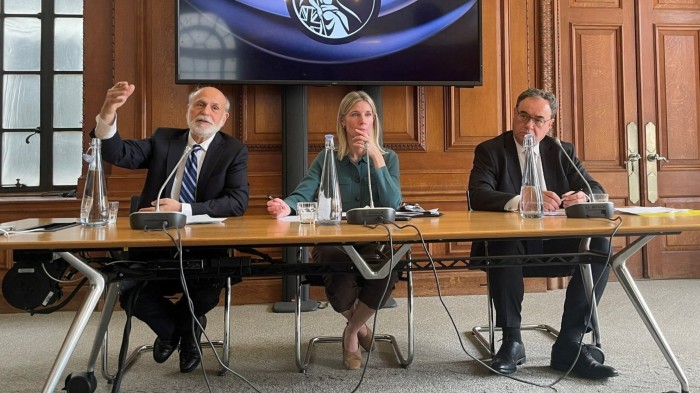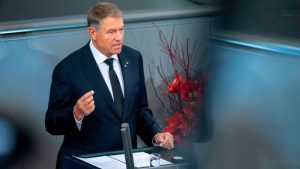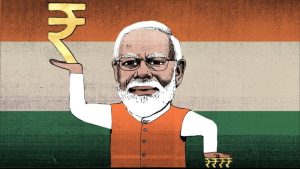Bernanke Review: No fan

Unlock the Editor’s Digest for free
Roula Khalaf, Editor of the FT, selects her favourite stories in this weekly newsletter.
The writer is a former professor of economics and senior adviser at the Bank of England.
There was a lot of talk about ‘scenarios’ at the recent Bank of England Watchers’ Conference, at which the Bank’s ongoing response to Ben Bernanke’s Review of the Bank’s models and forecasts was discussed. Put simply, scenarios are things that might or might not happen, but which it is worth discussing to make a point.
One scenario for how the last few years might have played out was that the surge in inflation, which peaked at 11.1 per cent, was in effect embraced by the Bank’s Monetary Policy Committee as the least-worst way of navigating the constriction of supply chains post-Covid, and the scarcity of food and energy commodities following Russia’s invasion of Ukraine. The alternative being (as former MPC member Silvana Tenreyro explained in her final speech as MPC member) a very sharp increase in interest rates that would have likely failed to suppress price increases, but sent the unemployment rate into double figures.
In this scenario, Bernanke would not have been hired by the Bank’s Court of Directors to review its models and forecasts, because it would be understood that they were not at fault, as the inflation surge was the accepted outcome and not an error. (An argument I made in my last piece for Alphaville, and which Jan Vlieghe, former MPC member, made at the conference).
As a result of there not being a Bernanke Review in this scenario, there would also be no Catch-22-like recommendation in the Review that the Bank itself review its models and forecasts. Staff would be relieved of the burden of making a strategic priority of recapitulating debates about the relative merits of ‘DSGE” vs ‘semi-structural’ models, an important debate that academia resolved decades ago, but central bankers struggle to.
I don’t want to consume too many words recapitulating this debate, partly for the same reasons I wish the Bank’s staff were not doing it, but also because it’s hard to do it in less than the thousands of papers that have already been written about it.
As briefly as I can: DSGE refers to models built by writing down first who are the people in the model and what are they trying to do, and working out what their decisions imply for how macro variables evolve. This recipe is designed so that policy experiments aren’t done on equations that relate one macro variable to another, but would change if the policy changed. It has its roots in the writings of Nobel winners Lucas, Sargent and Sims, who were responding to the failure of economic models to capture the 1970s stagflation. ‘Semi structural’ models are models that appeal to this other tradition, but also eschew some of the explicit mathematical foundations when the abstraction is hard to swallow, or hard to work out, or if practicality demands (eg a policymaker thinks variable x is affected by variable y and that is that).
Academia killed semi-structural models off because you might not be able to rely on policy simulations done on them (referred to as the Lucas Critique, after his 1976 paper about the problem). Central bankers partly persist with them, for good and bad reasons. The bad reason is that they say things like ‘I have to tell detailed stories’ or ‘I understand these models better’ which are scientifically unintelligible. The good reason is that often they are thinking of policy experiments that hardly differ from what was happening in the past so semi-structural models might be reliable enough.
I digress. Recall that I was describing a scenario in which the Bank wasn’t asked in a Review of its models to… review its models. It therefore wouldn’t have replayed this debate, and wouldn’t find itself — like any other protagonist — unable to resolve it, because in that scenario it was recognised there had not really been any policy error. And, therefore, there was no reason to think that some bad choice had been made about model type.
The rhetorical construct of this article is going to get confusing, because we are now also going to imagine that there was also no prolonged and tortuous discussion about how to present uncertainty, whether through scenarios, or fan charts, or forecasts from ensembles of models rather than a single model (or ‘suites’ as the Bank likes to call them).
This is another discussion which has no end, caught between the unavoidable reality that forecasts are forecasts of distributions and not single point numbers on the one hand, and diverging subjective views about what things are easier to explain to yourselves as a policy committee and the outside world on the other. And in this imaginary world (scenario!) this discussion wouldn’t have happened, because inadequately thinking about uncertainty wouldn’t have been at fault for the inflation surge, because — once again — the inflation surge had been chosen as the most desirable policy choice on offer.
Another part of this scenario I’d like readers to contemplate is that, while fixing its model and data-handling software — which, as Bernanke rightly notes, had deteriorated to the point of it risking that the MPC could not do its job — the Bank might have asked itself what senior management failings had led to things getting to that point. Which of the governors/deputy governors/chief economists had failed, and how? Better still, if the Treasury itself asked this question, it being the ultimate custodian of the Bank, and rightly concerned to avoid BoE marking its own leadership’s poor homework. Doing this would help make sure that a similar situation happened again at some point in the future.
And finally, my imaginary scenario is one where — by not doing a huge hiring surge to recapitulate old debates about monetary policy models — resources are instead freed up to devote to the new risks and threats that the past few years revealed to us. The fragilities in banking caused by the new social media-related runniness of deposits; the sensitivity to interest rate risk caused by monetary policy doing its job (see recent failures of Silicon Valley Bank and others); and the systemic risks embedded in pension fund asset management (the LDI crisis that precipitated Liz Truss’ exit from office).
Sadly, as readers will have noted, this scenario did not come to pass. In the real world, the Bank is instead prioritising fixing the inputs to monetary policy, which largely (data and software aside) did not in fact need fixing — since, for the last time, there hadn’t been a policy error.
Further reading:
— Big Ben calls time on Compass
#Bernanke #Review #fan




